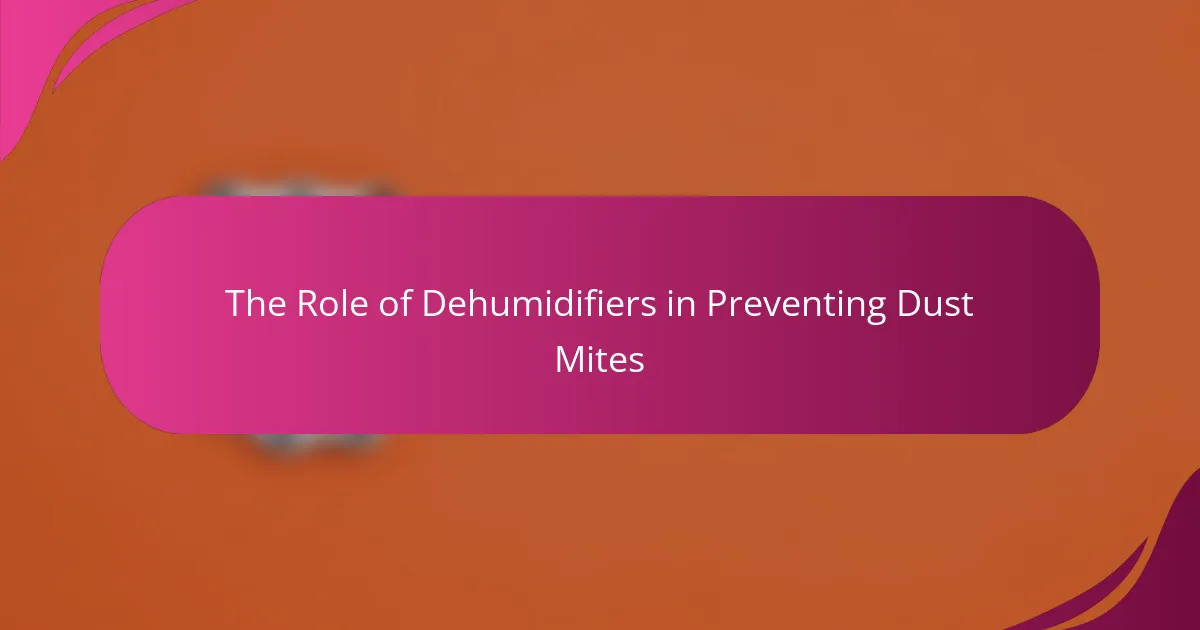Dehumidifiers are essential in preventing dust mites by effectively lowering humidity levels in homes, particularly in regions like Canada. By keeping humidity below 50%, these devices create an environment that is inhospitable for dust mites, significantly reducing their population and associated allergens.
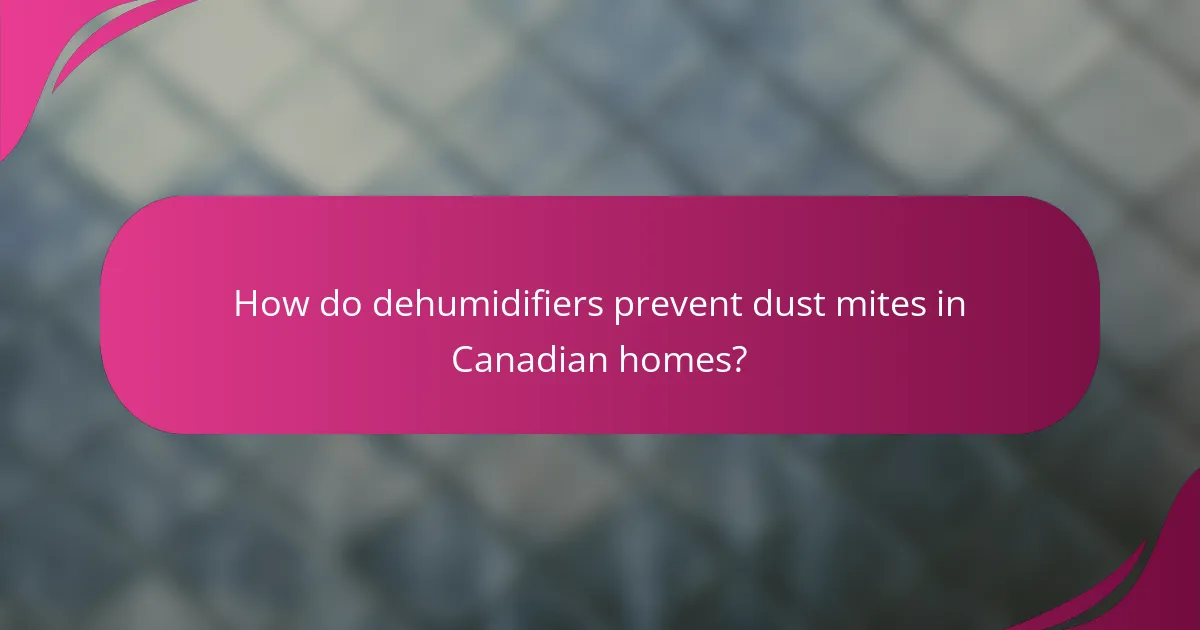
How do dehumidifiers prevent dust mites in Canadian homes?
Dehumidifiers play a crucial role in preventing dust mites by lowering humidity levels in Canadian homes, which creates an unfavorable environment for these pests. By maintaining humidity below 50%, dehumidifiers help reduce the conditions that allow dust mites to thrive.
Lower humidity levels
Dust mites thrive in environments with high humidity, typically above 50%. Dehumidifiers effectively lower indoor humidity levels, making it difficult for dust mites to survive and reproduce. In Canadian homes, setting your dehumidifier to maintain humidity between 30% and 50% is ideal for controlling dust mite populations.
Reduce dust mite population
By consistently lowering humidity, dehumidifiers can significantly reduce the dust mite population in your home. When humidity is kept low, dust mites struggle to find the moisture they need to live, leading to a decrease in their numbers. Regular use of a dehumidifier can lead to a noticeable reduction in allergy symptoms related to dust mites.
Improve indoor air quality
Using a dehumidifier not only helps control dust mites but also improves overall indoor air quality. Lower humidity reduces the growth of mold and mildew, which can contribute to respiratory issues. A dehumidifier can create a healthier living environment, particularly in humid regions of Canada where moisture is prevalent.
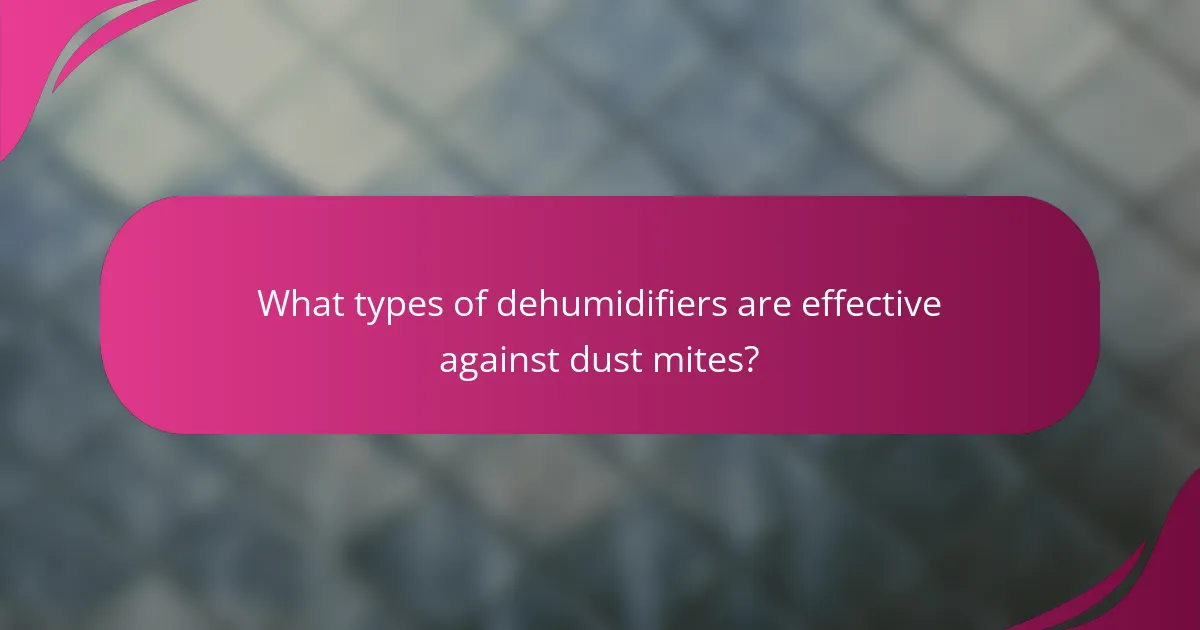
What types of dehumidifiers are effective against dust mites?
Dehumidifiers that effectively combat dust mites include desiccant, refrigerant, and whole-house models. Each type operates differently and has unique advantages, making them suitable for various environments and moisture levels.
Desiccant dehumidifiers
Desiccant dehumidifiers use hygroscopic materials to absorb moisture from the air. They are particularly effective in low-temperature environments, making them ideal for basements or unheated spaces where dust mites thrive.
These units typically operate quietly and consume less energy than refrigerant models. However, they may require more frequent maintenance, such as replacing the desiccant material, which can add to overall costs.
Refrigerant dehumidifiers
Refrigerant dehumidifiers work by cooling air to condense moisture, which is then collected in a reservoir. They are effective in warmer climates and can handle larger volumes of air, making them suitable for living spaces.
While they are generally more efficient at removing humidity, they can be noisier and consume more electricity. It’s essential to choose a model with a suitable capacity for your space to maximize effectiveness against dust mites.
Whole-house dehumidifiers
Whole-house dehumidifiers are integrated into the home’s HVAC system and regulate humidity levels throughout the entire house. This type is particularly beneficial for larger homes or areas with persistent humidity issues.
These systems can be more expensive to install but provide consistent humidity control, which is crucial for preventing dust mite infestations. Regular maintenance is necessary to ensure optimal performance and longevity.

What are the key features to consider when choosing a dehumidifier?
When selecting a dehumidifier, consider factors such as capacity, energy efficiency, and noise level to ensure it meets your needs effectively. These features will influence the unit’s performance, operational costs, and overall comfort in your living space.
Capacity for room size
The capacity of a dehumidifier is crucial as it determines how much moisture it can remove from the air in a given time. Units are typically rated by the number of pints of moisture they can extract per day, with common capacities ranging from 30 to 70 pints for residential use. Choose a model that matches the size of your room; for instance, a 30-pint unit is suitable for smaller spaces, while larger areas may require a 50 or 70-pint model.
To calculate the appropriate capacity, consider the square footage of the room and the humidity level. For example, a room of about 1,500 square feet with high humidity may need a more powerful unit compared to a smaller, less humid area.
Energy efficiency rating
Energy efficiency ratings indicate how much energy a dehumidifier uses to remove moisture, impacting your electricity bills. Look for units with the ENERGY STAR label, which signifies compliance with energy efficiency guidelines set by the U.S. Environmental Protection Agency. These models can reduce energy consumption by up to 15% compared to standard units.
When comparing models, check the energy factor (EF) rating, which measures the amount of moisture removed per kilowatt-hour of electricity consumed. A higher EF rating means better efficiency, so aim for units with an EF of at least 1.8 to ensure cost-effective operation.
Noise level
The noise level of a dehumidifier can significantly affect your comfort, especially in quiet environments like bedrooms or offices. Most dehumidifiers operate between 40 to 60 decibels, with quieter models being preferable for residential use. Check product specifications for noise ratings, and consider units with a low noise level if you plan to run them overnight or during work hours.
Some manufacturers offer features like “quiet mode” or “sleep mode,” which reduce noise during operation. If noise is a concern, look for models specifically designed for quiet operation, as they can provide effective moisture control without being disruptive.
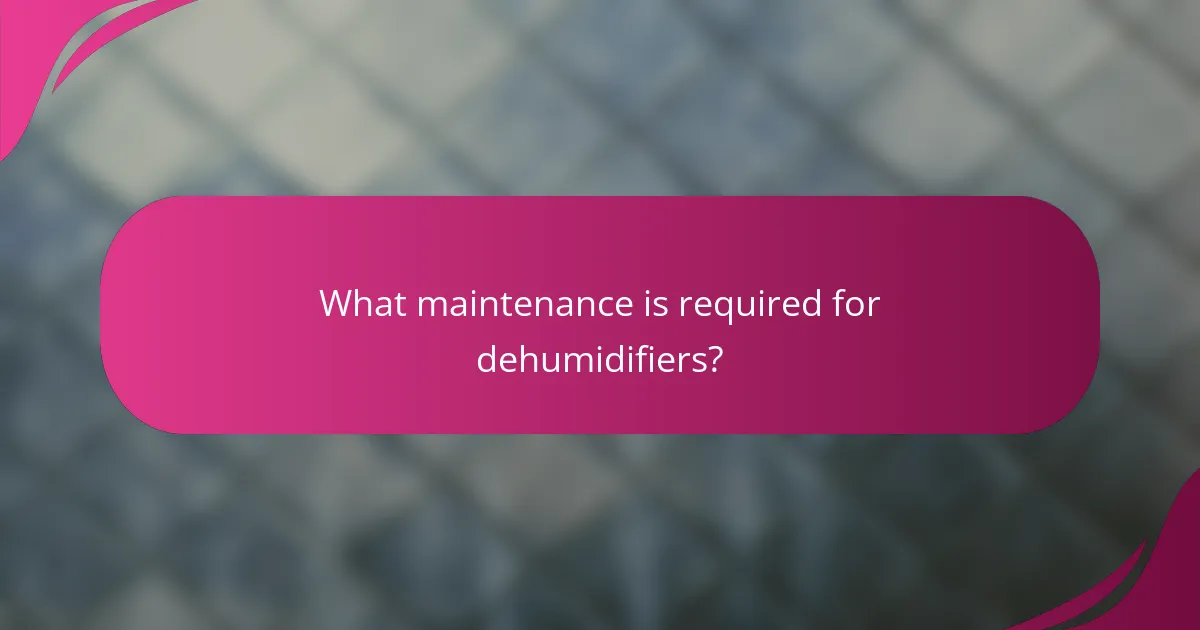
What maintenance is required for dehumidifiers?
Regular maintenance is essential for dehumidifiers to ensure optimal performance and longevity. Key tasks include cleaning filters, emptying and cleaning the tank, and conducting seasonal checks to prevent dust mite proliferation and maintain air quality.
Regular filter cleaning
Cleaning the filters of your dehumidifier is crucial for maintaining airflow and efficiency. Depending on usage, filters should be cleaned every few weeks or replaced every few months. A clogged filter can reduce the unit’s effectiveness and lead to increased energy consumption.
To clean the filter, remove it from the unit and wash it with warm, soapy water. Allow it to dry completely before reinserting it. Regular maintenance of filters can significantly enhance the dehumidifier’s performance and lifespan.
Tank emptying and cleaning
Emptying and cleaning the water tank is vital to prevent mold and bacteria growth. Most dehumidifiers have an indicator that alerts you when the tank is full, but it’s good practice to check it daily, especially in humid conditions.
When cleaning the tank, use a mixture of water and mild detergent, rinsing thoroughly to remove any residue. This should be done at least once a month to ensure a hygienic environment and optimal operation.
Seasonal checks
Conducting seasonal checks is important to ensure your dehumidifier is ready for the changing humidity levels throughout the year. Before the humid months, inspect the unit for any signs of wear, and ensure all components are functioning properly.
During these checks, verify that the power cord is in good condition, the unit is clean, and the settings are adjusted according to the expected humidity levels. This proactive maintenance can help avoid unexpected breakdowns and ensure effective dust mite prevention.
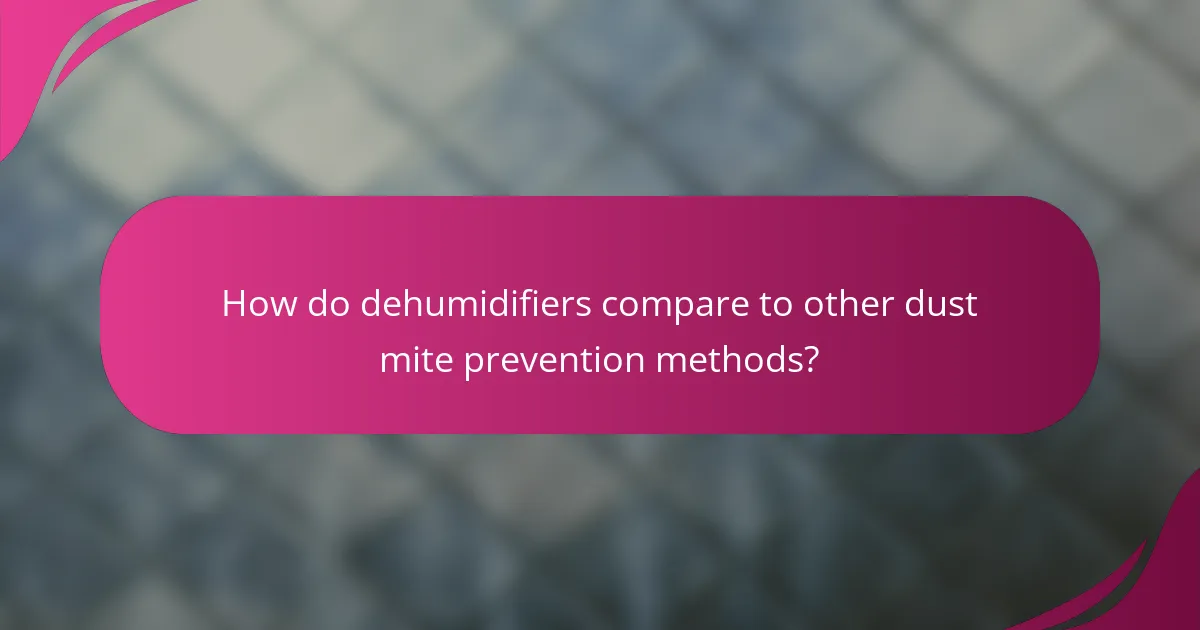
How do dehumidifiers compare to other dust mite prevention methods?
Dehumidifiers are effective in reducing dust mite populations by lowering humidity levels, which mites thrive in. Compared to other methods, they provide a consistent environment that discourages mite growth, making them a valuable tool in allergy management.
Air purifiers
Air purifiers help reduce dust mite allergens by filtering out particles from the air, including dust and mite waste. While they can improve air quality, they do not address humidity levels directly. For optimal results, using an air purifier in conjunction with a dehumidifier can create a more hostile environment for dust mites.
When choosing an air purifier, look for models with HEPA filters, as these can capture a significant percentage of airborne allergens. Regular maintenance, such as filter replacement, is crucial to ensure effectiveness.
Regular cleaning
Regular cleaning is essential for minimizing dust mite populations. Vacuuming carpets and upholstery with a vacuum equipped with a HEPA filter can significantly reduce dust mite allergens. Washing bedding in hot water at least once a week also helps eliminate mites and their waste.
In addition to vacuuming and washing, consider dusting surfaces with a damp cloth to prevent dust from becoming airborne. Using allergen-proof covers on mattresses and pillows can further protect against dust mites, creating a multi-faceted approach to prevention.
